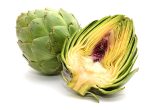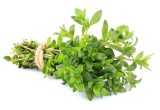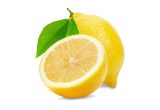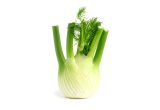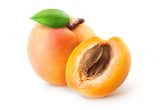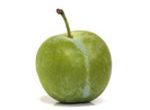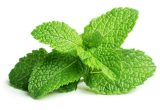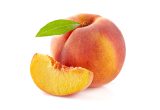Pepper (yellow)

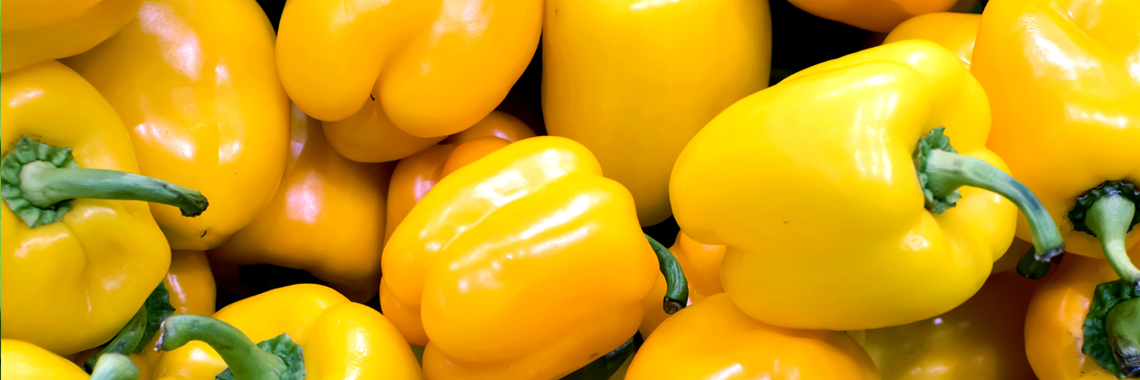
Description
- Yellow pepper is a member of the Solanaceae family, genus Apsicum, species annuum (Thuphairo, 2019). It is a sweet pepper, originating from the same plant as the red and green pepper. These different colours are determined by the stage of ripening. The pepper is green when not yet ripe. As it ripens, it turns yellow then orange then red (Nolte, 2012).
- It is native to the central regions of the American continent, namely Central America, southern North America, and northern South America (Nolte, 2012).
- Today, the main pepper producing countries are China, Turkey, Spain, Romania, Nigeria and Mexico (Nolte, 2012).
PHYSICAL AND ORGANOLEPTIC CHARACTERISTICS
- The presence of carotenoids, such as α and β-carotenes, zeaxanthin, lutein and β-cryptoxanthin gives the pepper its yellow colour (Howard, 2001).
- Yellow pepper, unlike green pepper, has a sweet taste due to its high glucose content produced during ripening, acidic components, as well as other volatile components, such as p-menth-1-en-9-al, (E)-b-ocimene, (Z)-2-penten-1-ol and (E) geranylacetone (Howard, 2001; Ghasemnezhad, 2011; Eggink, 2012).
- Capsaicin, the substance that provides “spiciness” to chillies, is present in small amounts in yellow pepper (Al Othman, 2011), hence the absence of the spicy taste within this variety.
- It can be eaten raw or cooked.
COMPOSITION CHARACTERISTICS (excluding macronutrients, vitamins and minerals)
- Yellow pepper represents a good source of antioxidants thanks to the carotenoids and polyphenols it contains (high amount of capsanthin, quercetin and luteolin) (Sun, 2007). Its antioxidant activity appears to be higher than that of green peppers (Shukla, 2016) and is not affected by cooking (Hamed, 2019).
RAW
The following values are approximate and depend on variety, season, ripeness, cultivation conditions, etc. Raw yellow peppers are low in energy*. On average, they provide 30.70 calories (kcal) per 100 g, i.e. 130 kJ. A yellow pepper weighs on average 125 to 250 g, which represents an energy intake of 38.37 to 76.75 kcal when raw.
COMPOSITION TABLES
For each nutrient, the tables provide information on the content, minimum and maximum values, as well as the percentage of the Dietary Reference Values (DRVs) per 100 g net of raw yellow pepper.
*Regulation (EC) No 1924/2006 of the European Parliament and of the Council of 20 December 2006 on nutrition and health claims made on foods.
MACRONUTRIENTS
| Constituent (g) | Average content |
Min-Max per 100g |
DRV% |
|---|---|---|---|
| Water | 91,9 | NC - 92 | - |
| Fibers | 1,20 | 0,90 - NC | - |
| Carbohydrates | 4,73 | 0 - NC | 1,82 |
| Sugars | 4,30 | - | 4,78 |
| Lipids | 0,30 | 0,21 - NC | 0,43 |
| Saturated fat | 0,11 | 0,031 - NC | 0,55 |
| Protein | 0,94 | NC - 1 | 1,88 |
| Constituent (g) | Amount | Min-Max | DRV% |
|---|---|---|---|
| Water | Ciqual 2020 (valeur issue de l'analyse Ciqual-Aprifel 2018) | - | - |
| Fibers | Ciqual 2020 (valeur issue de l'analyse Ciqual-Aprifel 2018) | - | - |
| Carbohydrates | Ciqual 2020 (valeur issue de l'analyse Ciqual-Aprifel 2018) | - | Règlement (UE) N°1169/2011 du parlement Européen, et du conseil du 25 octobre 2011 |
| Sugars | Ciqual 2020 (valeur issue de l'analyse Ciqual-Aprifel 2018) | - | Règlement (UE) N°1169/2011 du parlement Européen, et du conseil du 25 octobre 2011 |
| Lipids | Ciqual 2020 (valeur issue de l'analyse Ciqual-Aprifel 2018) | - | Règlement (UE) N°1169/2011 du parlement Européen, et du conseil du 25 octobre 2011 |
| Saturated fat | Ciqual 2020 (valeur issue de l'analyse Ciqual-Aprifel 2018) | - | Règlement (UE) N°1169/2011 du parlement Européen, et du conseil du 25 octobre 2011 |
| Protein | Ciqual 2020 | - | Règlement (UE) N°1169/2011 du parlement Européen, et du conseil du 25 octobre 2011 |
Zoom on carbohydrates
- Raw yellow peppers are low in sugar* as they contain less than 5 g per 100 g.
- The carbohydrate content of raw yellow pepper (4.73 g per 100 g) is slightly higher than the average carbohydrate quantity in raw vegetables (4.45 g per 100 g).
- These are mainly fructose (2.30 g per 100 g) and glucose (2 g per 100 g).
Zoom on fibres
- Raw yellow pepper provides 1.20 g of fibre per 100 g.
- This amount is lower than the average amount of fibre in raw vegetables (2.43 g per 100 g).
Zoom on proteins
- Raw yellow pepper provides less protein (0.94 g per 100 g) than the average quantity of this macronutrient in raw vegetables (1.87 g per 100 g).
Zoom on lipids
- Raw yellow pepper is fat-free* as it contains less than 0.5 g of fat per 100 g.
- Its fat content (0.30 g per 100 g) is lower than the average amount of this macronutrient in raw vegetables (0.56 g per 100 g).
*Regulation (EC) No 1924/2006 of the European Parliament and of the Council of 20 December 2006 on nutrition and health claims made on foods.
MINERALS AND TRACE ELEMENTS
| Constituent | Average content |
Min-Max per 100g |
DRV% |
|---|---|---|---|
| Calcium (mg) | 8,60 | NC - 11 | 1,08 |
| Chloride (mg) | 29,63 | - | 3,70 |
| Copper (mg) | 0,07 | NC - 0,11 | 7 |
| Iron (mg) | 0,21 | NC - 0,46 | 1,50 |
| Iodine (µg) | < 20 | - | - |
| Magnesium (mg) | 12 | - | 3,20 |
| Manganese (mg) | 0,11 | NC - 0,12 | 5,50 |
| Phosphorus (mg) | 23 | NC - 24 | 3,29 |
| Potassium (mg) | 220 | 212 - NC | 11 |
| Selenium (µg) | < 20 | - | - |
| Sodium (mg) | < 5 | 0 - NC | - |
| Zinc (mg) | 0,23 | 0,17 - NC | 2,30 |
| Constituent | Amount | Min-Max | DRV% |
|---|---|---|---|
| Calcium (mg) | Ciqual 2020 (valeur issue de l'analyse Ciqual-Aprifel 2018) | - | Règlement (UE) N°1169/2011 du parlement Européen, et du conseil du 25 octobre 2011 |
| Chloride (mg) | Ciqual 2020 (valeur issue de l'analyse Ciqual-Aprifel 2018) | - | Règlement (UE) N°1169/2011 du parlement Européen, et du conseil du 25 octobre 2011 |
| Copper (mg) | Ciqual 2020 (valeur issue de l'analyse Ciqual-Aprifel 2018) | - | Règlement (UE) N°1169/2011 du parlement Européen, et du conseil du 25 octobre 2011 |
| Iron (mg) | Ciqual 2020 (valeur issue de l'analyse Ciqual-Aprifel 2018) | - | Règlement (UE) N°1169/2011 du parlement Européen, et du conseil du 25 octobre 2011 |
| Iodine (µg) | Ciqual 2020 (valeur issue de l'analyse Ciqual-Aprifel 2018) | - | Règlement (UE) N°1169/2011 du parlement Européen, et du conseil du 25 octobre 2011 |
| Magnesium (mg) | Ciqual 2020 (valeur issue de l'analyse Ciqual-Aprifel 2018) | - | Règlement (UE) N°1169/2011 du parlement Européen, et du conseil du 25 octobre 2011 |
| Manganese (mg) | Ciqual 2020 (valeur issue de l'analyse Ciqual-Aprifel 2018) | - | Règlement (UE) N°1169/2011 du parlement Européen, et du conseil du 25 octobre 2011 |
| Phosphorus (mg) | Ciqual 2020 (valeur issue de l'analyse Ciqual-Aprifel 2018) | - | Règlement (UE) N°1169/2011 du parlement Européen, et du conseil du 25 octobre 2011 |
| Potassium (mg) | Ciqual 2020 (valeur issue de l'analyse Ciqual-Aprifel 2018) | - | Règlement (UE) N°1169/2011 du parlement Européen, et du conseil du 25 octobre 2011 |
| Selenium (µg) | Ciqual 2020 (valeur issue de l'analyse Ciqual-Aprifel 2018) | - | Règlement (UE) N°1169/2011 du parlement Européen, et du conseil du 25 octobre 2011 |
| Sodium (mg) | Ciqual 2020 (valeur issue de l'analyse Ciqual-Aprifel 2018) | - | - |
| Zinc (mg) | Ciqual 2020 (valeur issue de l'analyse Ciqual-Aprifel 2018) | - | Règlement (UE) N°1169/2011 du parlement Européen, et du conseil du 25 octobre 2011 |
Zoom on minerals and trace elements
- Raw yellow peppers contain a significant amount of potassium as they provide the equivalent of 11% of DRVs, i.e. 220 mg per 100 g.
- The other minerals and trace elements are present in raw yellow pepper in quantities representing less than 8% of DRVs.
VITAMINS
| Constituent | Average content |
Min-Max per 100g |
DRV% |
|---|---|---|---|
| Provitamin A Beta-carotene (µg) | 642 | 120 - NC | - |
| Vitamin A equivalent (µg) | 107 | 20 - NC | 13,38 |
| Vitamin B1 (mg) | 0,03 | 0,028 - NC | 2,73 |
| Vitamin B2 (mg) | < 0,01 | NC - 0,025 | - |
| Vitamin B3 (mg) | 0,28 | NC - 0,89 | 1,75 |
| Vitamin B5 (mg) | 0,14 | NC - 0,17 | 2,33 |
| Vitamin B6 (mg) | 0,079 | NC - 0,17 | 5,64 |
| Vitamin B9 (µg) | 43,30 | 26 - NC | 21,65 |
| Vitamin C (mg) | 121 | NC - 184 | 151,25 |
| Vitamin E (mg) | 1,76 | - | 14,67 |
| Vitamin K1 (µg) | 1,18 | - | 1,57 |
| Constituent | Amount | Min-Max | DRV% |
|---|---|---|---|
| Provitamin A Beta-carotene (µg) | Ciqual 2020 (valeur issue de l'analyse Ciqual-Aprifel 2018) | - | - |
| Vitamin A equivalent (µg) | Calcul à partir de la valeur Provitamine A Béta-carotène* | - | Règlement (UE) N°1169/2011 du parlement Européen, et du conseil du 25 octobre 2011 |
| Vitamin B1 (mg) | Ciqual 2020 (valeur issue de l'analyse Ciqual-Aprifel 2018) | - | Règlement (UE) N°1169/2011 du parlement Européen, et du conseil du 25 octobre 2011 |
| Vitamin B2 (mg) | Ciqual 2020 (valeur issue de l'analyse Ciqual-Aprifel 2018) | - | Règlement (UE) N°1169/2011 du parlement Européen, et du conseil du 25 octobre 2011 |
| Vitamin B3 (mg) | Ciqual 2020 (valeur issue de l'analyse Ciqual-Aprifel 2018) | - | Règlement (UE) N°1169/2011 du parlement Européen, et du conseil du 25 octobre 2011 |
| Vitamin B5 (mg) | Ciqual 2020 (valeur issue de l'analyse Ciqual-Aprifel 2018) | - | Règlement (UE) N°1169/2011 du parlement Européen, et du conseil du 25 octobre 2011 |
| Vitamin B6 (mg) | Ciqual 2020 (valeur issue de l'analyse Ciqual-Aprifel 2018) | - | Règlement (UE) N°1169/2011 du parlement Européen, et du conseil du 25 octobre 2011 |
| Vitamin B9 (µg) | Ciqual 2020 (valeur issue de l'analyse Ciqual-Aprifel 2018) | - | Règlement (UE) N°1169/2011 du parlement Européen, et du conseil du 25 octobre 2011 |
| Vitamin C (mg) | Ciqual 2020 (valeur issue de l'analyse Ciqual-Aprifel 2018) | - | Règlement (UE) N°1169/2011 du parlement Européen, et du conseil du 25 octobre 2011 |
| Vitamin E (mg) | Ciqual 2020 (valeur issue de l'analyse Ciqual-Aprifel 2018) | - | Règlement (UE) N°1169/2011 du parlement Européen, et du conseil du 25 octobre 2011 |
| Vitamin K1 (µg) | Ciqual 2020 (valeur issue de l'analyse Ciqual-Aprifel 2018) | - | Règlement (UE) N°1169/2011 du parlement Européen, et du conseil du 25 octobre 2011 |
Zoom on vitamins
- Raw yellow pepper is high in vitamin C as it provides the equivalent of 151.25% of DRVs, i.e. 121 mg per 100 g. According to the Ciqual 2020 table, raw yellow pepper is the 5th vegetable with the highest vitamin C content, after raw kale, cooked red pepper, cooked yellow pepper and raw red pepper.
- It is also a source of vitamin B9 as it provides the equivalent of 21.65% of DRVs, i.e. 43.30 µg per 100 g.
- Raw yellow pepper contains a significant amount of vitamin E and vitamin A. It provides the equivalent of:
- 14.67% of DRVs for vitamin E, i.e. 1.76 mg per 100 g;
- 13.38% of DRVs for vitamin A, i.e. 107 µg per 100 g.
- The other vitamins are present in smaller quantities, since they cover less than 6% of DRVs.
*Calculation made: Beta Carotene / 6 + retinol
POLYPHENOLS
| Constituent (mg) | Average content |
Min-Max per 100mg |
|---|---|---|
| Flavonoids (mg) | 0,90 | 0,20 - 2,31 |
| of which Flavonols (mg) | 0,42 | 0 - 1,26 |
| of which Flavones (mg) | 0,48 | 0,20 - 1,05 |
| Lignanes (mg) | 0,077 | 0,077 - 0,08 |
| Total polyphenols | 0,977 | 0,277 - 2,39 |
| Constituent (mg) | Amount | Min-Max |
|---|---|---|
| Flavonoids | Phénol-Explorer version 3.6 Méthode utilisée : Chromatographie après hydrolyse | - |
| of which Flavonols | Phénol-Explorer version 3.6 Méthode utilisée : Chromatographie après hydrolyse | - |
| of which Flavones | Phénol-Explorer version 3.6 Méthode utilisée : Chromatographie après hydrolyse | - |
| Lignanes | Phénol-Explorer version 3.6 Méthode utilisée : Chromatographie après hydrolyse | - |
| Total polyphenols | Phénol-Explorer version 3.6 Méthode utilisée : Chromatographie après hydrolyse | - |
Zoom on polyphenols (raw yellow pepper)
- Polyphenols are substances with an antioxidant effect.
- Flavones, a subgroup of flavonoids, are predominantly present in raw yellow pepper composites, accounting for about 49.13% of total polyphenols identified.
- Next come the flavonols, also a subgroup of flavonoids, representing 42.99% of total polyphenols respectively.
- Lignans represent the remaining 7.88% of total polyphenols.
SAUTÉED
The following values are approximate and depend on variety, season, ripeness, cultivation conditions, etc. Sautéed yellow peppers (without fat) are low in energy*. On average, they provide 35.80 calories (kcal) per 100 g, i.e. 150 kJ. A yellow pepper weighs on average 125 to 250 g, which represents an energy intake of 44.75 to 89.50 kcal when sautéed.
COMPOSITION TABLES
For each nutrient, the tables provide information on the content, minimum and maximum values, as well as the percentage of the Dietary Reference Values (DRVs) for 100 g net of yellow pepper sautéed without fat (except for the polyphenols table which refers to grilled yellow pepper).
*Regulation (EC) No 1924/2006 of the European Parliament and of the Council of 20 December 2006 on nutrition and health claims made on foods.
MACRONUTRIENTS
| Constituent (g) | Average content |
Min-Max per 100g |
DRV% |
|---|---|---|---|
| Water | 90,50 | - | - |
| Fibers | 2,20 | - | - |
| Carbohydrates | 5,33 | 0 - NC | 2,05 |
| Sugars | 4,90 | - | 5,44 |
| Lipids | 0,60 | - | 0,86 |
| Saturated fat | 0,19 | - | 0,95 |
| Protein | 1 | - | 2 |
| Constituent (g) | Amount | Min-Max | DRV% |
|---|---|---|---|
| Water | Ciqual 2020 (valeur issue de l'analyse Ciqual-Aprifel 2018) | - | - |
| Fibers | Ciqual 2020 (valeur issue de l'analyse Ciqual-Aprifel 2018) | - | Règlement (UE) N°1169/2011 du parlement Européen, et du conseil du 25 octobre 2011 |
| Carbohydrates | Ciqual 2020 | - | Règlement (UE) N°1169/2011 du parlement Européen, et du conseil du 25 octobre 2011 |
| Sugars | Ciqual 2020 (valeur issue de l'analyse Ciqual-Aprifel 2018) | - | Règlement (UE) N°1169/2011 du parlement Européen, et du conseil du 25 octobre 2011 |
| Lipids | Ciqual 2020 (valeur issue de l'analyse Ciqual-Aprifel 2018) | - | Règlement (UE) N°1169/2011 du parlement Européen, et du conseil du 25 octobre 2011 |
| Saturated fat | Ciqual 2020 (valeur issue de l'analyse Ciqual-Aprifel 2018) | - | Règlement (UE) N°1169/2011 du parlement Européen, et du conseil du 25 octobre 2011 |
| Protein | Ciqual 2020 (valeur issue de l'analyse Ciqual-Aprifel 2018) | - | Règlement (UE) N°1169/2011 du parlement Européen, et du conseil du 25 octobre 2011 |
Zoom on carbohydrates
- The carbohydrate content of sautéed yellow pepper (5.33 g per 100 g) is higher than the average carbohydrate quantity in cooked vegetables (4.85 g per 100 g).
- These are mainly fructose (2.60 g per 100 g) and glucose (2.30 g per 100 g).
Zoom on fibres
- It contains a significant amount of fibre: 2.20 g per 100 g.
- This amount is slightly lower than the average fibre quantity in cooked vegetables (2.89 g per 100 g).
Zoom on proteins
- Sautéed yellow peppers provide a much lower amount of protein (1 g per 100 g) than the average of this macronutrient in cooked vegetables (2 g per 100 g).
Zoom on lipids
- Sautéed yellow peppers are low in fat* as they contain less than 3 g of fat per 100 g.
- Their fat content (0.60 g per 100 g) is almost equivalent to the average amount of this macronutrient in cooked vegetables (0.53 g per 100 g).
*Regulation (EC) No 1924/2006 of the European Parliament and of the Council of 20 December 2006 on nutrition and health claims made on foods.
MINERALS AND TRACE ELEMENTS
| Constituent | Average content |
Min-Max per 100g |
DRV% |
|---|---|---|---|
| Calcium (mg) | 7,30 | - | 0,91 |
| Chloride (mg) | 25,35 | - | 3,17 |
| Copper (mg) | 0,06 | - | 6 |
| Iron (mg) | 0,23 | - | 1,64 |
| Iodine (µg) | < 20 | - | - |
| Magnesium (mg) | 11 | - | 2,93 |
| Manganese (mg) | 0,09 | - | 4,50 |
| Phosphorus (mg) | 23 | - | 3,29 |
| Potassium (mg) | 220 | - | 11 |
| Selenium (µg) | < 20 | - | - |
| Sodium (mg) | < 5 | - | - |
| Zinc (mg) | 0,14 | - | 1,40 |
| Constituent | Amount | Min-Max | DRV% |
|---|---|---|---|
| Calcium (mg) | Ciqual 2020 (valeur issue de l'analyse Ciqual-Aprifel 2018) | - | Règlement (UE) N°1169/2011 du parlement Européen, et du conseil du 25 octobre 2011 |
| Chloride (mg) | Ciqual 2020 (valeur issue de l'analyse Ciqual-Aprifel 2018) | - | Règlement (UE) N°1169/2011 du parlement Européen, et du conseil du 25 octobre 2011 |
| Copper (mg) | Ciqual 2020 (valeur issue de l'analyse Ciqual-Aprifel 2018) | - | Règlement (UE) N°1169/2011 du parlement Européen, et du conseil du 25 octobre 2011 |
| Iron (mg) | Ciqual 2020 (valeur issue de l'analyse Ciqual-Aprifel 2018) | - | Règlement (UE) N°1169/2011 du parlement Européen, et du conseil du 25 octobre 2011 |
| Iodine (µg) | Ciqual 2020 (valeur issue de l'analyse Ciqual-Aprifel 2018) | - | Règlement (UE) N°1169/2011 du parlement Européen, et du conseil du 25 octobre 2011 |
| Magnesium (mg) | Ciqual 2020 (valeur issue de l'analyse Ciqual-Aprifel 2018) | - | Règlement (UE) N°1169/2011 du parlement Européen, et du conseil du 25 octobre 2011 |
| Manganese (mg) | Ciqual 2020 (valeur issue de l'analyse Ciqual-Aprifel 2018) | - | Règlement (UE) N°1169/2011 du parlement Européen, et du conseil du 25 octobre 2011 |
| Phosphorus (mg) | Ciqual 2020 (valeur issue de l'analyse Ciqual-Aprifel 2018) | - | Règlement (UE) N°1169/2011 du parlement Européen, et du conseil du 25 octobre 2011 |
| Potassium (mg) | Ciqual 2020 (valeur issue de l'analyse Ciqual-Aprifel 2018) | - | Règlement (UE) N°1169/2011 du parlement Européen, et du conseil du 25 octobre 2011 |
| Selenium (µg) | Ciqual 2020 (valeur issue de l'analyse Ciqual-Aprifel 2018) | - | Règlement (UE) N°1169/2011 du parlement Européen, et du conseil du 25 octobre 2011 |
| Sodium (mg) | Ciqual 2020 (valeur issue de l'analyse Ciqual-Aprifel 2018) | - | - |
| Zinc (mg) | Ciqual 2020 (valeur issue de l'analyse Ciqual-Aprifel 2018) | - | Règlement (UE) N°1169/2011 du parlement Européen, et du conseil du 25 octobre 2011 |
Zoom on minerals and trace elements
- Sautéed yellow peppers contain a significant amount of potassium, equivalent to 11% of DRVs, i.e. 220 mg per 100 g.
- The other minerals and trace elements are present in smaller quantities because they represent less than 7% of DRVs.
VITAMINS
| Constituent | Average content |
Min-Max per 100g |
DRV% |
|---|---|---|---|
| Provitamin A Beta-carotene (µg) | 837 | - | - |
| Vitamin A equivalent (µg) | 139,50 | - | 17,44 |
| Vitamin B1 (mg) | 0,03 | - | 2,73 |
| Vitamin B2 (mg) | 0,047 | - | 3,36 |
| Vitamin B3 (mg) | 0,56 | - | 3,50 |
| Vitamin B5 (mg) | 0,16 | - | 2,67 |
| Vitamin B6 (mg) | 0,24 | - | 17,14 |
| Vitamin B9 (µg) | 57,10 | - | 28,55 |
| Vitamin C (mg) | 126 | - | 157,50 |
| Vitamin E (mg) | 2,12 | - | 17,67 |
| Vitamin K1 (µg) | < 0,80 | - | - |
| Constituent | Amount | Min-Max | DRV% |
|---|---|---|---|
| Provitamin A Beta-carotene (µg) | Ciqual 2020 (valeur issue de l'analyse Ciqual-Aprifel 2018) | - | - |
| Vitamin A equivalent (µg) | Calcul à partir de la valeur Provitamine A Béta-carotène* | - | Règlement (UE) N°1169/2011 du parlement Européen, et du conseil du 25 octobre 2011 |
| Vitamin B1 (mg) | Ciqual 2020 (valeur issue de l'analyse Ciqual-Aprifel 2018) | - | Règlement (UE) N°1169/2011 du parlement Européen, et du conseil du 25 octobre 2011 |
| Vitamin B2 (mg) | Ciqual 2020 (valeur issue de l'analyse Ciqual-Aprifel 2018) | - | Règlement (UE) N°1169/2011 du parlement Européen, et du conseil du 25 octobre 2011 |
| Vitamin B3 (mg) | Ciqual 2020 (valeur issue de l'analyse Ciqual-Aprifel 2018) | - | Règlement (UE) N°1169/2011 du parlement Européen, et du conseil du 25 octobre 2011 |
| Vitamin B5 (mg) | Ciqual 2020 (valeur issue de l'analyse Ciqual-Aprifel 2018) | - | Règlement (UE) N°1169/2011 du parlement Européen, et du conseil du 25 octobre 2011 |
| Vitamin B6 (mg) | Ciqual 2020 (valeur issue de l'analyse Ciqual-Aprifel 2018) | - | Règlement (UE) N°1169/2011 du parlement Européen, et du conseil du 25 octobre 2011 |
| Vitamin B9 (µg) | Ciqual 2020 (valeur issue de l'analyse Ciqual-Aprifel 2018) | - | Règlement (UE) N°1169/2011 du parlement Européen, et du conseil du 25 octobre 2011 |
| Vitamin C (mg) | Ciqual 2020 (valeur issue de l'analyse Ciqual-Aprifel 2018) | - | Règlement (UE) N°1169/2011 du parlement Européen, et du conseil du 25 octobre 2011 |
| Vitamin E (mg) | Ciqual 2020 (valeur issue de l'analyse Ciqual-Aprifel 2018) | - | Règlement (UE) N°1169/2011 du parlement Européen, et du conseil du 25 octobre 2011 |
| Vitamin K1 (µg) | Ciqual 2020 (valeur issue de l'analyse Ciqual-Aprifel 2018) | - | Règlement (UE) N°1169/2011 du parlement Européen, et du conseil du 25 octobre 2011 |
Zoom on vitamins
- Sautéed yellow pepper is high in vitamin C as it provides the equivalent of 157.50% of DRVs, i.e. 126 mg per 100 g. According to the Ciqual 2020 table, cooked yellow pepper is the second most vitamin C-rich cooked vegetable after red pepper.
- It is also a source of:
- vitamin B9 because it provides the equivalent of 28.55% of DRVs, i.e. 57.10 µg per 100 g;
- vitamin E because it provides the equivalent of 17.67% of DRVs, i.e. 2.12 mg per 100 g;
- vitamin A because it provides the equivalent of 17.44 % of DRVs, i.e. 139.50 µg per 100 g;
- vitamin B6 because it provides the equivalent of 17.14% of DRVs, i.e. 0.24 mg per 100 g.
- The other vitamins are present in smaller quantities, since they cover less than 4% of DRVs.
*Calculation made: Beta Carotene / 6 + retinol
POLYPHENOLS
| Constituent (mg) | Average content |
Min-Max per 100mg |
|---|---|---|
| Total polyphenols | 1,06 | 0,68 - 1,44 |
| Constituent (mg) | Amount | Min-Max |
|---|---|---|
| Total polyphenols | Phénol-Explorer version 3.6 Méthode utilisée : Dosage du folin | - |
Zoom on polyphenols (grilled yellow pepper)
- Polyphenols are substances with an antioxidant effect.
- According to the folin method, grilled yellow peppers contain 1.06 mg of polyphenols per 100 g.
Nutrition and health claims
NUTRITION CLAIMS OF RAW YELLOW PEPPER
- Low in energy (100 g of raw yellow pepper provide less than 40 kcal)
- Low in sugar (100 g of raw yellow pepper provide less than 5 g per 100 g)
- Fat-free (100 g of raw yellow pepper does not contain more than 0.5 g fat)
- High in vitamin C (100 g of raw yellow pepper provide more than 30% of DRVs)
- Source of vitamin B9 (100 g of raw yellow pepper provide more than 15% of DRVs)
HEALTH CLAIMS (for a consumption of 100 g of raw pepper)
Vitamin C
- Vitamin C contributes to:
- normal function of the immune system during and after intense physical exercise,
- normal collagen formation for the normal function of blood vessels,
- normal collagen formation for the normal function of bones,
- normal collagen formation for the normal function of cartilage,
- normal collagen formation for the normal function of gums,
- normal collagen formation for the normal function of skin,
- normal collagen formation for the normal function of teeth,
- normal energy-yielding metabolism,
- normal functioning of the nervous system,
- normal psychological function,
- normal function of the immune system,
- protection of cells from oxidative stress,
- reduction of tiredness and fatigue,
- regeneration of the reduced form of vitamin E.
- Vitamin C increases iron absorption.
Folates or vitamin B9
- Folates contribute to:
- maternal tissue growth during pregnancy,
- normal amino acid synthesis,
- normal blood formation,
- normal homocysteine metabolism,
- normal psychological function,
- normal function of the immune system,
- reduction of tiredness and fatigue.
- Folates have a role in the process of cell division.
Nutrition and health claims
According to the definitions of nutrition claims as set out in Regulation (EC) No 1924/2006 on nutrition and health claims, and in view of the composition of cooked yellow pepper, the following claims may be used:
NUTRITION CLAIMS OF SAUTEED YELLOW PEPPER (without fat)
- Low in energy (100 g of sautéed yellow pepper provide less than 40 kcal)
- Low in fat (100 g of sautéed yellow pepper provide less than 3 g of fat)
- High in vitamin C (100 g of sautéed yellow pepper provide more than 30% of DRVs)
- Source of vitamin B9 (100 g of sautéed yellow pepper provide more than 15% of DRVs)
- Source of vitamin E (100 g of sautéed yellow pepper provide more than 15% of DRVs)
- Source of vitamin A (100 g of sautéed yellow pepper provide more than 15% of DRVs)
- Source of vitamin B6 (100 g of sautéed yellow pepper provide more than 15% of DRVs)
HEALTH CLAIMS (for a consumption of 100 g of sautéed yellow pepper)
Vitamin C
- Vitamin C contributes to:
- normal function of the immune system during and after intense physical exercise,
- normal collagen formation for the normal function of blood vessels,
- normal collagen formation for the normal function of bones,
- normal collagen formation for the normal function of cartilage,
- normal collagen formation for the normal function of gums,
- normal collagen formation for the normal function of skin,
- normal collagen formation for the normal function of teeth,
- normal energy-yielding metabolism,
- normal functioning of the nervous system,
- normal psychological function,
- normal function of the immune system,
- protection of cells from oxidative stress,
- reduction of tiredness and fatigue,
- regeneration of the reduced form of vitamin E.
- Vitamin C increases iron absorption.
Folates or vitamin B9
- Folates contribute to:
- maternal tissue growth during pregnancy,
- normal amino acid synthesis,
- normal blood formation,
- normal homocysteine metabolism,
- normal psychological function,
- normal function of the immune system,
- reduction of tiredness and fatigue.
- Folates have a role in the process of cell division.
Vitamin E
- Vitamin E contributes to the protection of cells from oxidative stress.
Vitamin A
- Vitamin A has a role in the process of cell specialisation.
- Vitamin A contributes to:
- maintenance of normal skin,
- maintenance of normal mucous membranes,
- maintenance of normal vision,
- normal iron metabolism,
- normal function of the immune system.
Vitamin B6
- Vitamin B6 contributes to:
- normal cysteine synthesis,
- normal homocysteine metabolism,
- normal energy-yielding metabolism,
- normal functioning of the nervous system,
- normal protein and glycogen metabolism,
- normal psychological function,
- normal red blood cell formation,
- normal function of the immune system,
- reduction of tiredness and fatigue,
- regulation of hormonal activity.
References
- Agence nationale de sécurité sanitaire de l’alimentation, de l’environnement et du travail. Table de composition nutritionnelle des aliments Ciqual 2020. Consultée le 08/09/2020 depuis le site internet Ciqual https://ciqual.anses.fr/
- Al Othman ZAAI, Ahmed YBH, Habila MA, Ghafar AA. Determination of Capsaicin and Dihydrocapsaicin in Capsicum Fruit Samples Using High Performance Liquid Chromatography. Molecules (Basel, Switzerland). 2011;16(10):8919 29.
- Eggink PM, Maliepaard C, Tikunov Y, Haanstra JPW, Bovy AG, Visser RGF. A Taste of Sweet Pepper: Volatile and Non-Volatile Chemical Composition of Fresh Sweet Pepper (Capsicum Annuum) in Relation to Sensory Evaluation of Taste. Food Chemistry. 2012;132(1):301-10.
-
Ghasemnezhad M, Sherafati M, Ali Payvast G. Variation in Phenolic Compounds, Ascorbic Acid and Antioxidant Activity of Five Coloured Bell Pepper (Capsicum Annum) Fruits at Two Different Harvest Times. Journal of Functional Foods. 2011;3(1):44-9.
-
Hamed M, Kalita D, Bartolo ME, Jayanty SS. Capsaicinoids, Polyphenols and Antioxidant Activities of Capsicum Annuum: Comparative Study of the Effect of Ripening Stage and Cooking Methods. Antioxidants (Basel, Switzerland). 2019;8(9):364.
-
Howard LR (2001). Handbook of Nutraceuticals and Functional Foods. Wildman RC , 229 p.
-
Neveu V, Perez-Jiménez J, Vos F, Crespy V, du Chaffaut L, Mennen L, Knox C, Eisner R, Cruz J, Wishart D, Scalbert A. (2010) Phenol-Explorer: an online comprehensive database on polyphenol contents in foods. Database, doi: 10.1093/database/bap024. Full text (free access)
-
Nolte KD. 2012. Sweet peppers [en ligne}. [Consulté le 21/02/2020]. Disponible à l’adresse : https://cpb-us-e1.wpmucdn.com/wordpressua.uark.edu/dist/0/310/files/2017/06/International-spinach-conference-Kurt-Nolte.pdf
-
Règlement (CE) N° 1924/2006 du Parlement européen et du Conseil du 20 décembre 2006 concernant les allégations nutritionnelles et de santé portant sur les denrées alimentaires.
-
Règlement (UE) N°432/2012 de la Commission du 16 mai 2012 établissant une liste des allégations de santé autorisées portant sur les denrées alimentaires, autres que celles faisant référence à la réduction du risque de maladie ainsi qu’au développement et à la santé infantiles.
-
Règlement (UE) n°1169/2011 du Parlement européen et du Conseil du 25 octobre 2011 concernant l’information des consommateurs sur les denrées alimentaires, modifiant les règlements (CE) n°1924/2006 et (CE) n°1925/2006 du Parlement européen et de Conseil et abrogeant la directive 87/250/CEE de la Commission, la directive 90/496/CEE du Conseil, la directive 1999/10/CE de la Commission, la directive 200/13/CE du Parlement européen et du Conseil, les directives 2002/67/CE et 2008/5/CE de la Commission et le règlement (CE) n°608/2004 de la Commission.
-
Shukla S, Kumar DA, Anusha SV, Tiwari AK. Antihyperglucolipidaemic and Anticarbonyl Stress Properties in Green, Yellow and Red Sweet Bell Peppers (Capsicum Annuum L.). Natural Product Research. 2016;30(5):583 9.
-
Sun T, Xu Z, Wu CT, Janes M, Prinyawiwatkul W, No HK. Antioxidant Activities of Different Colored Sweet Bell Peppers (Capsicum Annuum L.). Journal of Food Science. 2007;72(2): S98-102.
- Thuphairo K, Sornchan P, Suttisansanee U. Bioactive Compounds, Antioxidant Activity and Inhibition of Key Enzymes Relevant to Alzheimer’s Disease from Sweet Pepper (Capsicum annuum) Extracts. Prev Nutr Food Sci. 2019;24(3):327-37.




